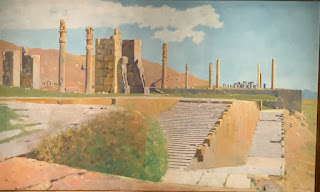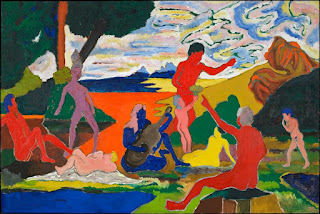Contemporary classical realist painters trace their lineage back to the Boston school of the early twentieth century. They combined the tight formal drawing of the French Academy with the looser brushwork and bolder colors of Impressionism. Leaders included Edmund Tarbell, William Paxton, Joseph Decamp, and Frank Benson. Benson (1862-1951) is the one best known in Chicago. Two of his paintings now hang in the Art Institute; one more is the highlight of the Vanderpoel Museum in Beverly.
Joseph Lindon Smith (1863-1950) was Benson’s friend and classmate both in Boston and Paris. Today he may best be known as the subject for a great portrait by Benson - but back in the day, he dominated his chosen subject matter: the representation of antiquities. And so it was that in 1935, the seventy two year old artist was invited by James Henry Breasted, the founder of the Oriental Institute at the University of Chicago, to accompany an archeological expedition to Persepolis.
Skilled draftsmen are often needed in such projects to document shapes too faint to be identifiable by photograph. But Smith’s large paintings appear to have served a more aesthetic purpose. As gallery signage confirms, “He conformed solely to his own distinctive style”. Excavation may be drudgery, but once uncovered, the monuments of past empires can be appreciated as the glorious foundation of contemporary civilization. Or, at least, that’s how those at the top, like the “Boston Brahmins”, might like to have seen it. Isabella Stewart Gardner, founder of her eponymous art museum in Boston, was one of Smith’s patrons.
Of Smith’s six Persepolis pieces, three are landscape views of the entire site with whatever architectural elements still remained. Depictions of ancient ruins often appeared in the annual Salons of the French Royal Academy. Populated with tourists or travelers, they invoke a romantic sentiment of transitory glory. But Smith presents the broken walls and surviving columns just as an Impressionist might paint the cliffs and saguaro cactus of the Sonoran desert. He’s mostly concerned with light and space. These are pleasant views, though more like prose than poetry.
Smith’s three depictions of the 4th century BC sculptural reliefs are also pleasant. His contour lines feel as chiseled as limestone. The spaces within them have been rendered with chromatic blended areas of thin paint, much like a watercolor. Missing or damaged details have been repaired. The results would fit the decor of an elegant, modern living space. But that is far from the powerful, almost unnerving effect of the original stone carvings, one of which, happily, has recently arrived in Chicago after an eighty year loan to the Museum of Fine Arts, Boston.
If you walk around to the other end of the museum, you will find it. One of the most vibrant pieces of ancient sculpture in this or any museum. It is not the same piece that Smith painted, but it is indeed, very, very close. Evidently, this repetitive motif of mortal combat between bull and lion was designed to convince subservient rulers of the majesty, and potential violence, of the Persian king of kings. Probably Smith’s patrons wanted something more genteel. Their old school wealth was threatened by the explosive growth of American capitalism just as their tame academic art was being overwhelmed by brash Modernists like Picasso. Both the refinement of Smith and the ferocity of the ancient sculpture have become anachronisms in the art world a hundred years later. But both still can be appreciated.








